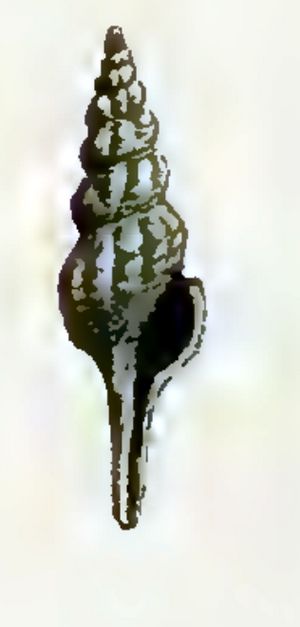Comitas wynyardensis facts for kids
Quick facts for kids Comitas wynyardensis |
|
|---|---|
 |
|
| Original image of a shell of Comitas wynyardensis | |
| Scientific classification | |
| Synonyms | |
|
Pleurotoma wynyardensis G.B. Pritchard, 1896 |
Comitas wynyardensis is an extinct species of sea snail. This ancient marine gastropod was a type of mollusc. It belonged to the family Pseudomelatomidae, which includes many turrid snails.
Contents
About Comitas wynyardensis
This snail could grow up to 27 millimeters (about an inch) long. It was about 8 millimeters wide.
What Did Its Shell Look Like?
The shell of Comitas wynyardensis was small to medium-sized. It had a narrow, spindle-like shape. The opening of the shell, called the aperture, and its long, tube-like front part (the siphonal canal) were about the same length as the pointy top part (the spire).
The spire was sharp and made up of several whorls. These whorls gradually got bigger. The very first part of the shell, called the protoconch, was small and smooth. The main part of the spire had seven or eight rounded whorls. They had a clear line, or suture, between them.
The shell's opening was oval-shaped. The outer lip was thin and smooth. It had a wide, shallow dip just below the suture. From this dip, the lip curved forward. It then curved down to join the siphonal canal. This canal was long, straight, and open.
The inner lip of the shell had a thin, shiny coating. The central pillar of the shell, called the columella, was simple and smooth. It was straight and tapered gently towards the front.
Shell Decorations
The shell surface had slanted ribs. These ribs were highest in the middle of each whorl. They faded out more quickly towards the back of the shell. There were usually nine ribs on each whorl. Sometimes, there were up to eleven or twelve ribs on the main body whorl. The strength of these ribs could vary. On some shells, they were barely visible.
These ribs were crossed by both thick and thin spiral lines. There were four to six thicker lines that stood out more. These were mainly on the front two-thirds of each whorl. They were especially noticeable where they crossed the ribs. On the body whorl, there were about eight or nine of these thicker lines. Between them were finer threads. The back third of the shell had many very fine spiral threads. The shell also showed fine growth lines from the snail's development.
Where Did It Live?
This marine species lived only in Australia. Scientists have found its fossils in Eocene rock layers. These fossils were discovered at Table Cape in Tasmania. The Eocene period was a long time ago, about 56 to 33.9 million years ago!

